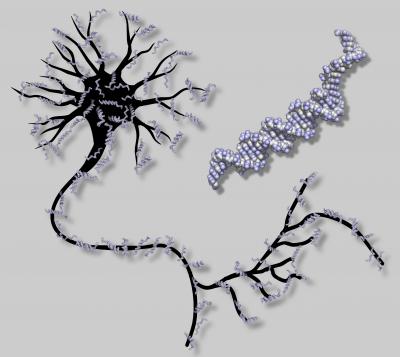Artificial neural network created from DNA
July 21, 2011

An artificial neural network made from DNA (credit: Caltech)
Researchers at the California Institute of Technology (Caltech) have made an artificial neural network out of DNA, creating a circuit of interacting molecules that can recall memories based on incomplete patterns, just as a brain can.
The research demonstrates how molecular systems can exhibit autonomous brain-like behaviors.
How it works
Using a simple DNA gate architecture that allows experimental scale-up of multilayer digital circuits, the researchers systematically transformed arbitrary linear threshold circuits (an artificial neural network model) into DNA strand displacement cascades that function as small neural networks.
That approach enabled them to implement a Hopfield associative memory with four fully connected artificial neurons made from 112 distinct DNA strands. After training in silico, it remembers four single-stranded DNA patterns and recalls the most similar one when presented with an incomplete pattern.
To build the DNA neural network, the researchers used a process called a strand-displacement cascade that uses single and partially double-stranded DNA molecules. The latter are double helices, one strand of which sticks out like a tail.
While floating around in a water solution, a single strand can run into a partially double-stranded one, and if their bases (the letters in the DNA sequence) are complementary, the single strand will grab the double strand’s tail and bind, kicking off the other strand of the double helix. The single strand thus acts as an input, while the displaced strand acts as an output, which can then interact with other molecules.
Demonstration game
As a test and demonstration, the artificial neural network plays a mind-reading game in which it tries to identify a mystery scientist. The researchers “trained” the neural network to “know” four scientists, whose identities are each represented by a specific, unique set of answers to four yes-or-no questions, such as whether the scientist was British.
After thinking of a scientist, a human player provides an incomplete subset of answers that partially identifies the scientist. The player then conveys those clues to the network by dropping DNA strands that correspond to those answers into the test tube. Communicating via fluorescent signals, the network then identifies which scientist the player has in mind.
“Intelligent” DNA system possible
The results suggest that DNA strand displacement cascades could be used to endow autonomous chemical systems with the capability of recognizing patterns of molecular events, making decisions and responding to the environment. Uses could include biomedical diagnostics, such as classifying cancers with microRNA signals. Furthermore, when DNA strand displacement systems are provided with interfaces for sensing non-nucleic-acid inputs and controlling chemical reactions as output actions, an “intelligent” DNA system could directly perceive and act on its chemical environment.
While this “proof-of-principle” experiment shows the promise of creating DNA-based networks that can “think,” this particular neural network is limited, the researchers said. It doesn’t easily scale to 100 billion neurons (the size of a human brain), and is slow to process information. However, the researchers also said that engineering these systems could provide indirect insight into the evolution of intelligence and biological information processing.
Ref.: Lulu Qian, Erik Winfree, Jehoshua Bruck, Neural network computation with DNA strand displacement cascades, Nature, 2011; 475 (7356): 368 [DOI: 10.1038/nature10262]
